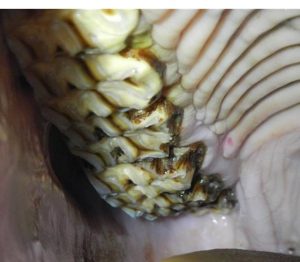What is peripheral dental caries?
Peripheral dental caries is a severe form of tooth decay that affects the outside layer of the cheek teeth (the cementum of the molars). In severe cases, it can extend into the enamel and dentine.

The image on the right shows a moderate case of peripheral dental caries. The first two teeth are normal – you can see the creamy white layer of cementum bulging on the sides. The third tooth is affected – the back half of the tooth is missing cementum. The last three teeth are totally missing the outside cementum layer. You can see a small amount at the gum line that hasn’t been eaten away yet.
This is a fairly common condition, especially in Western Australia where it is estimated around 60% of horses have peripheral dental caries.
Why is this a problem?
The decay can cause a number of issues. Firstly, the unprotected enamel can get really sharp and lacerate the delicate structures in the mouth. Secondly, the underlying enamel is very brittle and, without the cementum to support it, is prone to tooth fractures.
The most serious effect is secondary periodontal disease. The decay forms gaps in the teeth which food gets stuck in and rots, leading to tooth infections, tooth root abscesses and early loss of teeth. This is incredibly painful and some horses suffer for years.
Risk Factors
A study by Dr Kirsten Jackson, an equine dental veterinarian in Western Australia, has recently looked into the risk factors for this condition and is trying to find out how we can stop our horses getting this painful condition.
One of the most significant risk factors was the type of hay fed to the horse. Horses on oaten hay were almost twice as likely to have the caries compared to horses not on oaten hay. Horses on meadow hay were less than half as likely to have the caries compared to those not on meadow hay (meadow hay was protective).
It is thought that this is because of the high water soluble carbohydrate (sugar) content in cereal hays. Oaten hay can have 20-40% sugar content compared to 6% sugar content of lucerne hay.
The study also found water source was important. Horses on rain water were more likely to have tooth decay than horses on bore or drinking water. This is thought to be because the rain water is more acidic.
The length of access the horse had to pasture was also significant. Horses out at pasture for 8-12 months of the year were less likely to be affected than horses with minimal grazing.
There is much more research to be done in this area, however this exciting new study will help us to treat those horses with the dental decay and prevent others getting affected in the future.
If you are concerned your horse may have peripheral dental caries, book an appointment with your equine vet for a dental examination. Remember, all horses need at least yearly dental exams to make sure their teeth and mouths remain healthy.




A dentist is not typically exciting and to prevent this kind of adventures I believe we should start taking better
care of our teeth as well as health generally.